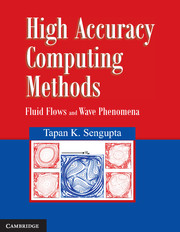Book contents
- Frontmatter
- Contents
- Foreward
- Preface
- Chapter 1 Basic Ideas of Scientific Computing
- Chapter 2 Governing Equations in Fluid Mechanics
- Chapter 3 Classification of Quasi-Linear Partial Differential Equations
- Chapter 4 Waves and Space–Time Dependence in Computing
- Chapter 5 Spatial and Temporal Discretizations of Partial Differential Equations
- Chapter 6 Solution Methods for Parabolic Partial Differential Equations
- Chapter 7 Solution Methods for Elliptic Partial Differential Equations
- Chapter 8 Solution of Hyperbolic PDEs: Signal and Error Propagation
- Chapter 9 Curvilinear Coordinate and Grid Generation
- Chapter 10 Spectral Analysis of Numerical Schemes and Aliasing Error
- Chapter 11 Higher Accuracy Methods
- Chapter 12 Introduction to Finite Volume and Finite Element Methods
- Chapter 13 Solution of Navier–Stokes Equation
- Chapter 14 Recent Developments in Discrete Finite Difference Computing
- Exercises
- References
- Index
Chapter 11 - Higher Accuracy Methods
Published online by Cambridge University Press: 05 January 2014
- Frontmatter
- Contents
- Foreward
- Preface
- Chapter 1 Basic Ideas of Scientific Computing
- Chapter 2 Governing Equations in Fluid Mechanics
- Chapter 3 Classification of Quasi-Linear Partial Differential Equations
- Chapter 4 Waves and Space–Time Dependence in Computing
- Chapter 5 Spatial and Temporal Discretizations of Partial Differential Equations
- Chapter 6 Solution Methods for Parabolic Partial Differential Equations
- Chapter 7 Solution Methods for Elliptic Partial Differential Equations
- Chapter 8 Solution of Hyperbolic PDEs: Signal and Error Propagation
- Chapter 9 Curvilinear Coordinate and Grid Generation
- Chapter 10 Spectral Analysis of Numerical Schemes and Aliasing Error
- Chapter 11 Higher Accuracy Methods
- Chapter 12 Introduction to Finite Volume and Finite Element Methods
- Chapter 13 Solution of Navier–Stokes Equation
- Chapter 14 Recent Developments in Discrete Finite Difference Computing
- Exercises
- References
- Index
Summary
Introduction
From previous discussions, it is apparent that it is possible to solve sets of differential equations numerically for practical parameter ranges, by solving PDEs with stringent requirements of resolving wide ranges of spatial and temporal scales. In the literature, one comes across a number of efforts which solve Navier–Stokes equation for turbulent flows at moderate Re. Also, large RAM machines are now available at desk-top, allowing one to solve problems with large number of grid points. This encourages search for faster methods; faster than the methods discussed in previous chapters. Higher accuracy methods are expected to fulfill this, as these allow solving the same problem with fewer grid points. Conversely, same methods allow solving problems at higher Reynolds number with the same grid. This chapter deals with developments and analyses of higher accuracy methods.
Effectiveness of CFD schemes is generally ranked by the leading order term of the Taylor series expansion used to define the truncation error of any scheme. It is expected that higher the order, better will be the quality of the scheme. While this may appear as a correct expectation, discussions in Chapters 8 and 10 will convince the readers that classification of schemes simply based on order of truncation error is incomplete. In Chapter 10, schemes were assessed based on their behaviour in the spectral plane. The Fourier spectral method provides maximum accuracy and it is seen that higher the order of explicit schemes, better is the representation.
Information
- Type
- Chapter
- Information
- High Accuracy Computing MethodsFluid Flows and Wave Phenomena, pp. 256 - 340Publisher: Cambridge University PressPrint publication year: 2013
